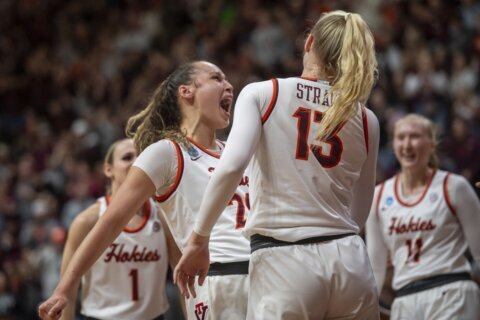Many students dream of attending one of the colleges in the elite Ivy League for their undergraduate education.
While getting accepted to one of the eight Ivy League schools in America, including No. 1-ranked Princeton University, has long been notoriously difficult, admission at top colleges overall has become increasingly challenging as more students apply.
The average acceptance rate among Ivy League colleges in fall 2019 was 7%, U.S. News statistics reveal. The average acceptance rate at all other National Universities — schools that offer a full range of undergraduate majors, plus master’s and doctoral programs — was about 65.5% for the same time period.
Early applicants to Ivy League schools are admitted more often than regular applicants. The explanation for this difference is that early applicants tend to have more competitive credentials than applicants who submit their materials later, according to Ivy League admissions officials.
Brown University, for example, includes the following disclaimer on its undergraduate admissions website: “Our pool of early applicants tends to include a very high proportion of exceptionally talented students and a higher rate of admission for Early Decision applicants reflects that phenomenon. It does not imply an automatic advantage for all early candidates. We admit Early Decision applicants only when we are confident that we would offer them admission as a Regular Decision applicant.”
[Read Consider Both Liberal Arts Colleges, National Universities.]
Dartmouth College provides a similar disclaimer on its website, explaining that elevated admissions rates for early applicants are partially explained by the fact that many early applicants are recruited athletes.
“Keep in mind that the published higher percentage of applicants accepted early is somewhat misleading because it includes recruited Division 1 athletes, whose credentials have been reviewed in advance,” the website states. “With recruited athletes removed from the Early Decision numbers, the statistical advantage isn’t as large.”
An aspiring student athlete is generally more likely to be accepted into an Ivy League school than a nonathlete with similar or even slightly better academic credentials, according to some admissions experts.
Each Ivy League college offers an early admissions program. Five of the eight Ivy League universities have binding early decision programs that require students who apply early to commit to attend if they are accepted. In contrast, three Ivy League undergraduate institutions — Princeton, Harvard University and Yale University — have nonbinding early action programs that permit students who are admitted early to subsequently apply to other colleges. However, all three of these schools have restrictive early action programs, meaning that early applicants to these schools must abide by certain limits in terms of how and where else they apply early.
Among the eight Ivy League schools, five provided U.S. News with information about their early acceptance rates. And at each of these five schools, early acceptance rates dwarfed regular acceptance rates.
For instance, at Columbia University, students who applied through the college’s early decision program were four times as likely to get in than students who applied later. The school’s early decision acceptance rate was 16%, whereas its acceptance rate for regular decision applicants was only 4%. The school’s overall acceptance rate for fall 2019 was 5%.
[Read: 10 Tips to Inspire College Essays.]
Columbia’s college admissions website states that the reason for the discrepancy between its early and regular admissions rates is that especially confident and well-qualified applicants tend to apply early.
“Although a larger percentage of the Early Decision applicant pool is admitted than of the Regular Decision pool, that higher acceptance rate reflects the remarkable strength of a self-selected group of applicants, the site states. “A candidate to whom we otherwise would not offer admission is not going to be accepted simply because he or she applied under the Early Decision program.”
Applicants typically need to have high test scores and top-notch grades to land a spot at an Ivy League school. The average early acceptance rate among Ivy League schools that provided their early admissions statistics to U.S. News was 17.8% for fall 2019.
The average early decision acceptance rate for non-Ivy National Universities that offer an early decision program was about 54.4% for fall 2019 admission, according to U.S. News data. In contrast, the average early action acceptance rate at non-Ivy National Universities that offer an early action program was 67.8%.
Every Ivy League school except Columbia provided U.S. News with information about the average SAT scores among their 2019 college freshmen who reported SAT scores. The average SAT evidence-based reading and writing score among freshmen at these schools was almost 732, while the average math score was nearly 761 out of a total 800 for each part, according to 2019 data that Ivy League schools submitted to U.S. News. Both of those SAT section scores are 97th percentile scores, meaning that these scores are either equal to or superior to those achieved by 97% of SAT test takers.
Neither Columbia nor Cornell University reported information about the average ACT score among admitted students who submitted ACT scores. Among the six Ivy League schools that reported the average ACT score among admitted students who reported those test results, the average score was just under 34 out of 36, a score that sits between the 98th and 99th percentile, meaning that it meets or exceeds the performance of 98% to 99% of all ACT test-takers.
[Read: ACT vs. SAT: How to Decide Which Test to Take.]
Every Ivy League institution provided U.S. News with information about the proportion of 2019 freshmen who had graduated in the top 10% of their high school classes. Among the eight Ivy League universities, the average share of freshmen who ranked in the top 10% of their high school class was nearly 92%.
Ivy League institutions may be reach schools for most college hopefuls, so applicants could benefit from looking beyond these schools to less selective colleges that align with their academic and career interests. There are also plenty of highly rated, very selective schools that aren’t in the Ivy League.
Students interested in applying to Ivy League schools — all in the top 20 of the U.S. News National Universities rankings — can explore the chart below. It includes important statistics to help prepare for the admissions process.
| School (state) | Overall acceptance rate | Early decision or action acceptance rate | Freshmen in top 10% of high school class (fall 2019) | U.S. News National Universities rank |
| Columbia University (NY) | 5% | 16% (ED) | 96% | 3 |
| Harvard University (MA) | 5% | Data not provided | 93% | 2 |
| Princeton University (NJ) | 6% | 14% (EA) | 91% | 1 |
| Yale University (CT) | 6% | Data not provided | 92% | 4 (tie) |
| Brown University (RI) | 7% | 18% (ED) | 91% | 14 (tie) |
| Dartmouth College (NH) | 8% | 23% (ED) | 95% | 13 |
| University of Pennsylvania | 8% | 18% (ED) | 94% | 8 |
| Cornell University (NY) | 11% | Data not provided | 83% | 18 |
Want to learn more about other top colleges? Access the U.S. News College Compass to find enrollment data, complete rankings and much more. Sign up for the U.S. News Extra Help: College Admissions free email newsletter to receive expert advice twice a month.
U.S. News surveyed more than 1,900 colleges and universities for the 2020 survey of undergraduate programs. Schools self-reported myriad data regarding their academic programs and the makeup of their student body, among other areas, making U.S. News’ data the most accurate and detailed collection of college facts and figures of its kind. The enrollment data above are correct as of Sept. 17, 2020.
More from U.S. News
4 Factors to Consider Before Applying to Ivy League Schools
10 Tips to Inspire College Essays
A Complete Guide to the College Application Process
What It Takes to Get Into the Ivy League originally appeared on usnews.com
Update 09/17/20: This article has been updated to reflect the 2021 rankings.







